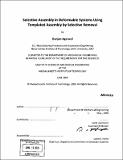| dc.contributor.advisor | Carol Livermore. | en_US |
| dc.contributor.author | Agarwal, Gunjan | en_US |
| dc.contributor.other | Massachusetts Institute of Technology. Dept. of Mechanical Engineering. | en_US |
| dc.date.accessioned | 2010-01-07T20:54:51Z | |
| dc.date.available | 2010-01-07T20:54:51Z | |
| dc.date.copyright | 2009 | en_US |
| dc.date.issued | 2009 | en_US |
| dc.identifier.uri | http://hdl.handle.net/1721.1/50571 | |
| dc.description | Thesis (S.M.)--Massachusetts Institute of Technology, Dept. of Mechanical Engineering, 2009. | en_US |
| dc.description | Includes bibliographical references (p. 140-143). | en_US |
| dc.description.abstract | The current work presents the first demonstration of successful assembly of deformable polymer microspheres on patterned rigid substrates using Templated Assembly by Selective Removal (TASR). Also presented is a quantitative model for predicting the successful self-assembly of deformable materials using TASR. Successful assembly of silica microspheres using TASR on a silicon template carried out in previous work has established that the technique works effectively for assembly of hard materials on a rigid substrate. However, the situation for the assembly of soft materials is different. In systems comprising soft materials, the contact area between the two mating surfaces can potentially change via deformation which influences the shape matching between the component and the substrate that TASR relies on as its underlying principle. The contact area at the interface is in turn decided by the nature of contact between the two interacting surfaces. Therefore, the Hertzian elastic theory for contact between a sphere was used for deciding whether the assembly of two new materials is attributed to shape matching or to plastic deformation. In accordance with the stated hypothesis, it was concluded that the assembly of Polystyrene (PS) microspheres on a rigid substrate such as silicon will yield successful results. Experiments were conducted to confirm this deduction from theoretical analysis. | en_US |
| dc.description.abstract | (cont.) The thesis presents simultaneous self assembly of 2 [mu]m diameter polystyrene microspheres on a patterned silicon template, where grids with uniformly well-matched hole sizes were completely filled demonstrating nearly 100% assembly yield while grids with varying hole sizes demonstrate selectivity in assembly. Quantitative comparison of the data on assembly of deformable systems with existing TASR models for non-deformable systems shows significant agreement. The predictive model for self assembly of deformable materials can pave the way for assessing the viability of trying out the assembly of a new material by comparing its parametric values with those that have already been successfully demonstrated and established. | en_US |
| dc.description.statementofresponsibility | by Gunjan Agarwal. | en_US |
| dc.format.extent | 143 p. | en_US |
| dc.language.iso | eng | en_US |
| dc.publisher | Massachusetts Institute of Technology | en_US |
| dc.rights | M.I.T. theses are protected by
copyright. They may be viewed from this source for any purpose, but
reproduction or distribution in any format is prohibited without written
permission. See provided URL for inquiries about permission. | en_US |
| dc.rights.uri | http://dspace.mit.edu/handle/1721.1/7582 | en_US |
| dc.subject | Mechanical Engineering. | en_US |
| dc.title | Selective assembly in deformable systems using templated assembly by selective removal | en_US |
| dc.type | Thesis | en_US |
| dc.description.degree | S.M. | en_US |
| dc.contributor.department | Massachusetts Institute of Technology. Department of Mechanical Engineering | |
| dc.identifier.oclc | 464224497 | en_US |
